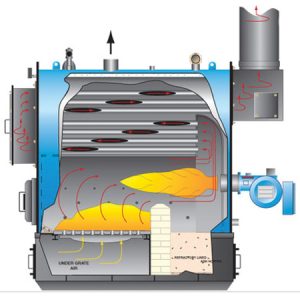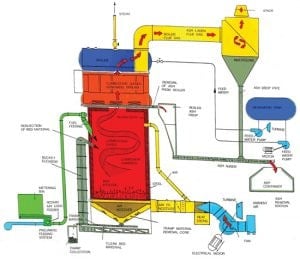Under the previous EPA Non-Hazardous Secondary Materials rule, treated wood was forbidden to be used as boiler fuel; however, EPA recently issued an amendment permitting creosote-treated wood to be used as boiler fuel under special conditions.
By PH Haroz and Nash Skipper
In the March 21, 2011 Non-Hazardous Secondary Materials (NHSM) rule and its February 7, 2013 amendment, EPA stated that creosote-treated wood, including Creosote-Treated Railroad Ties (CTRTs),1 contained contaminates at levels that are not comparable to those found in traditional fuels (such as wood or coal) that creosote-treated wood would replace. Therefore, this material was not permitted to be burned in boilers that are not classified as Commercial and Industrial Solid Waste Incinerators.
Upon issuance of the NHSM rule, trade associations such as the American Forest and Paper Association, the American Wood Council, and the Treated Wood Council submitted extensive data to EPA supporting their claim that treated wood, including CTRTs, should be considered NHSM and should therefore be permitted to be burned in boilers under the Boiler MACT rule.
February 8, 2016 Amendment to the NHSM Rule
Based on the information and comments submitted to EPA, an amendment to the NHSM rule was issued on February 8, 2016. This amendment was effective March 9, 2016. Under the amended NHSM rule, creosote-treated wood, including CTRTs, are permitted to be burned in boilers under the following conditions:
- CTRTs must be burned in an existing stoker, bubbling bed, fluidized bed or hybrid suspension grate boiler (see Figures 1 and 2, below and page 36).
- CTRTs can comprise no more than 40 percent of the fuel that is used on an annual heat input basis.
- Existing boilers that burn CTRTs must have been designed to burn both fuel oil and biomass (see Figure 3, page 37).
- CTRTs can be burned in boilers at major pulp and paper mills and at power production facilities subject to the Boiler MACT rule only if the boilers were previously designed to burn biomass, fuel oil, and coal but were modified (e.g., oil delivery equipment removed) to use natural gas instead of fuel oil.
- Existing boilers must combust fuel oil as part of normal operations and not solely as part of the start-up or shut down operation.
- Existing is defined as constructed before April 14, 2014.
Discarded CTRTs Are Not Permitted to be Burned in Boilers
CTRTs removed from service and stored in a railroad right of way or other location for over one year cannot be burned in boilers as NHSM. The assertion that the CTRTs are a valuable commodity even after being stored for over a year does not alter their status as solid waste that is not permitted to be used as boiler fuel. The only way to use railroad ties that have been removed from service and stored for over a year is by processing them. Processing includes operations that transform discarded NHSM as follows:
- Remove or destroy contaminants
- Significantly improve the fuel characteristics (e.g., sizing or drying of the material, in combination with other operations)
- Chemically improve the as-fired energy content
- Improve the ingredient characteristics
Minimal operations that result only in modifying the size of the material by shredding does not constitute processing for the purpose of the definition. Specifically, EPA concludes that the following meets the definition of processing CTRTs:
- Contaminants (spikes, nails, plates, etc.) are removed using a magnet.
- The fuel characteristics of the material are improved when the crossties are ground or shredded to a specified size depending on the particular needs of the end-use boiler. The grinding may occur in one or more phases. Once the CTRTs are ground, there may be additional screening to bring the material to a specified size.
Additional Considerations
- Even though it is addressed above, it is important to understand that CTRTs are not permitted to be burned in units designed to burn only biomass. To be able to meet the requirements of this rule, the unit must be designed to burn both biomass and fuel oil.
- When CTRTs are combusted in Hybrid Suspension Grate (HSG) boilers, the emission limits for carbon monoxide (CO) and particulate matter (PM) are higher than the limits for stoker boilers. The emission limit for stoker boilers is 1,500 parts per million (ppm) for CO and 0.037 pounds per million Btu heat input (lb/MMBtu) for PM. For HSG boilers, the limit is 2,800 ppm for CO and 0.44 lb/MMBtu for PM (almost 12 times higher). To be classified as an HSG boiler, the moisture content of biomass fuels must be 40 percent or greater on an average annual basis. To take advantage of those higher emissions limits, the HSG boiler operator must prove that the boiler meets the requirements of the HSG boiler subcategory by conducting monthly determinations of the moisture content of any biomass fuels, including CTRTs. Since CTRTs have a moisture content of 20 percent on average, this will limit the use of CTRTs for operators of HSG boilers wanting to take advantage of higher emission limits.
- Because boilers must operate in compliance with state air permits, they can burn CTRTs only if they meet the conditions listed in this rule and are permitted to do so under their state air permit.
- Boilers designed to burn only coal and biomass are not permitted to burn CTRTs.
- Railroad ties that are dual-treated with creosote and borate are not considered NHSM, and therefore are not permitted to be burned in boilers under this rule. The absence of dual-treated wood in this rule does not necessarily preclude suppliers from determining that dual-treated ties are non-wastes. Instead of relying on this rule’s non-NHSM determination, the suppliers can instead follow the procedures outlined in 40 CFR 241.3 to make a determination that the dual-treated railroad ties can be burned in boilers.
- EPA received a petition from the Treated Wood Council requesting that railroad ties treated with creosote borate, copper napthenate and copper napthenate-borate should also be permitted to be burned in boilers as NHSM under the Boiler MACT rule. Based on information provided to EPA to date, EPA believes that these three types of treated railroad ties are candidates to be permitted to be burned in boilers as NHSM. EPA expects to begin development of a proposal to list these materials as NHSM in the near future. In the meantime, EPA permits a de minimis amount of creosote borate, copper napthenate and copper napthenate-borate material to be mixed with CTRTs when burned as NHSM in boilers.
Conclusions
EPA issued an amendment to the NHSM rule that became effective March 9, 2016. Under the amendment, creosote-treated wood is considered NHSM and is permitted to be used as boiler fuel under special conditions. Other types of treated wood are not considered NHSM and are not permitted to be used as boiler fuel. CTRTs that are stored for over a year are considered discarded under the amendment, making them solid waste and not NHSM. Therefore, unless they have been processed, CTRTs that are stored for over a year are not permitted to be used as boiler fuel.
As a result of petitions submitted by trade organizations, EPA expects to begin development of a proposal to permit railroad ties treated with creosote borate, copper napthenate and copper napthenate-borate to be burned in boilers as NHSM under the Boiler MACT rule. In the interim, EPA permits a de minimis amount of those materials to be mixed with CTRTs when burned as NHSM in boilers. Another option is to follow procedures outlined in 40 CFR 241.3 to make a determination that those materials should be categorized as NHSM.
This amendment changes the dynamic for the solid waste and recycling industry. CTRTs are now permitted to be used as fuel under Boiler MACT. However, close attention must be paid to the limiting special conditions under which the CTRTs can be burned in boilers. Unfortunately, the special conditions will exclude numerous boilers that were previously permitted to burn CTRTs. The limiting conditions for burning CTRTs as NHSM and the current low price of fuel oil and natural gas is an obstacle in the conversion of CTRTs to energy. On the other hand, there are some boilers that meet the special conditions and will be able to continue to convert the CTRTs to energy, reducing the substantial burden on landfills. | WA
PH Haroz is President of Conversion Technology Inc. (Norcross, GA), an environmental and safety engineering consulting firm. He has a Master’s Degree in Mechanical Engineering from the Georgia Institute of Technology. PH can be reached at (770) 263-6330 or e-mail [email protected].
Nash Skipper, EIT is an Environmental Engineer at Conversion Technology, Inc. He has a Bachelor’s of Science Degree in Civil Engineering from the Georgia Institute of Technology.
Note
Creosote-treated railroad ties means railway support ties treated with wood preservative containing creosols and phenols made from coal tar oil.


